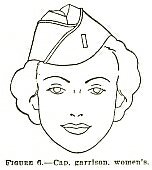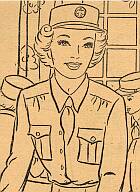Miscellaneous
.
Headgear
.
WAAC/WAC Cap (Hobby Hat)
.
The WAAC cap was a stiff visored hat with semi-stiff crown and cloth
chin-strap at the base of the crown later commonly known as Hobby hat (after
the first WAAC director Olveta Hobby). Considerations of a garrison cap
for enlisted WAAC personnel, like that for enlisted male soldiers, was
denied mainly for two reasons. First, an identical cap for enlisted personnel
and officers was favored as more democratic. Secondly, it was feared WAAC
members could be mixed up with other women's volunteer groups and private
service organizations (especially possible misconduct) because these often
wore garrison caps with their uniform. The WAAC cap should be able to shield
the eyes, not blow off in parades, as well as be distinctly military in
appearance.
.
.CAP,
WAAC, Summer, Officer's
.
made of cotton khaki twill. Note
the officer's
WAAC eagle and olive drab plastic
buttons.
|
. |
.Cap,
WAAC, Winter, Member's
.
The enlisted cap insignia was the
WAAC eagle mounted on a disc. Olive-drab plastic buttons with imprinted
WAAC eagle were fixed on both sides of the cap. The chin strap placed above
the visor of the cap could be used if necessary. |
.
The WAAC cap caused much trouble cleaning and reblocking (it was
even out of shape when issued). The stiffening was increased later but
it still remained a problem to keep it in correct shape. Furthermore, it
was quite uncomfortable to wear the hat for a long time because the completely
round shape did not match most head forms and caused skin discomfort.
After conversion to the WAC, the cap device and side buttons were
replaced by the Army officer's cap device and regulation Army buttons.
The "Hobby hat" was worn until early 1945.
.
.
Garrison Caps
.
| In April 1944 the often requested garrison cap for the WAC was approved.
The stiff WAC cap clearly had turned out to be impractical for many of
the increased number of jobs that WAC personnel was assigned to during
1943.
Especially WAC members who served overseas had complained repeatedly
about lacking facilities to clean and block the visored dress cap. They
already preferred wearing the officially unauthorized male pattern garrison
cap. |
............ |
Lt. Helen I. Allen
wearing a male garrison cap
with her service uniform in 1944
|
.
.
|
|
....... |
Garrison Caps, Male Pattern
On the top: male officer's
wool winter garrison cap with black-gold braid and silver 1st Lt.bar is
shown.
In the middle: pink officer's
garrison cap to be worn with the "pinks and greens" combination.
Below: enlisted male wool
garrison cap with enlisted WAC Pallas Athene insignia. |
.
.
| Unlike the straight cut men's garrison cap, the WAC
garrison cap was designed in the shape of a "banana" to fit better over
women's longer haircuts. However, many WAC members did not receive this
female version before the end of the war.
Garrison caps for enlisted WAC personnel had
a green-yellow braid while it was black-gold for officers. |
.... |
 .
Correct wear of the women's
garrison cap
.
Correct wear of the women's
garrison cap
|
.
.
Overview: WAC Garrison Caps
.
First row: winter
caps
left: cap, garrison, wool,
WAC, wool covert fabric to match the winter uniform of enlisted women.
right: cap,
garrison, wool, women, officers' made of dark olive drab wool barathea
material
.
Second row: caps for wear with
the summer off-duty dress
left: cap, garrison, beige,
WAC
right: cap, garrison, beige,
women, officer's
Both caps are made of rayon shantung
cloth.
.
Third and last row: summer caps
left: cap, garrison, tropical-worsted,
khaki, WAC for enlisted personnel
right: cap, garrison, tropical
worsted, women's, officer's
last row: cap, garrison,
cotton, khaki, WAC for enlisted personnel |
.. |
|
.
Fatigue Caps
.
|
. |
.... |
Hat, WAAC, Summer
The WAAC received a Daisy Mae style fatigue
cap made of khaki cotton twill. It was worn with the WAC coveralls, HBT
uniform and the exercise suit. |
.
.
| Due to the problems with storing and reblocking
the visored WAAC cap (Hobby hat), it was suggested to improve the appearance
of the summer fatigue hat and use it as less formal outfit consisting of
skirt, shirtwaist and summer hat (for example in WAAC training centers).
This way the visored WAAC cap could be limited to occasions which actually
required a dress uniform.
In the summer of 1943 a revised model of the
summer hat was introduced. It was made of khaki twill fabric and could
be turned up or down in back. |
..... |
The Revised Summer Hat
|
.
|
|
..... |
Cap, Herringbone Twill
The wearing of this male pattern
herringbone twill visored cap was adopted for field duty and fatigue details
later during the war. |
.
|
If the weather was colder, members
of the WAC wore the wool knit cap with the Herringbone Twill work uniform
or other field clothing. |
..... |
.Cap,
Wool, Knit, M-1941
.
The double fold of this wool knit cap
with reinforced visor could be pulled down over the ears for extra warmth
(like shown on the right photo). The same cap was also issued to Army men. |
.
Shirtwaists
.
WAAC shirtwaists were often criticized because of their bad fitting
collars. On the one hand, the pattern made by producers of men's shirts
was cut too big for most women's necks. On the other hand, the production
of the WAAC shirts given to women's clothing manufacturers merely sized
the shirts in different bust sizes instead of collar measurements. This
was general practice with female clothing because most collar types on
women's blouses did not require exact fitting, unlike the standing collar
with tie worn by men. A revised pattern with a smaller collar and larger
bust was approved as a final compromise. A complete change to several collar
sizes and sleeve lengths was declined as too time-consuming due to the
need for extra storing and shipping.
Since large stocks of the unsatisfactory shirts were already procured,
they had to be issued throughout 1943 and 1944.
.
|
|
.v |
|
Shirtwaist, Cotton, Women's
.
made of khaki broadcloth. It has two
breast pockets with pleats and buttoned flaps. Left flap and pocket provided
with pencil opening. |
. |
Shirtwaist, Wool, Women's
.
made of wool shirting flannel in
olive drab color. It has two breast pockets with buttoned flaps. Left flap
and pocket provided with pencil opening. |
..
|
|
.v |
WAAC/WAC service shirtwaists and shirts had a 4 button closing,
two breast pockets and darts at waistline for proper fit. Officers could
wear shirtwaists without shoulder loops like enlisted personnel if they
did not intend to wear these without the jacket.
Shirtwaist, Tropical-worsted, Khaki, Women's
.
made of khaki tropical worsted
fabric. Left flap and pocket provided with pencil opening. The Officer's
version with shoulder loops is shown on the photo. |
.
|
|
... |
|
Shirtwaist, Dark Olive Drab
.
made of dark olive drab broadcloth.
This optional shirtwaist was worn by officers only (for example on dress
occasions). It was worn with the winter service jacket and a khaki tie.
The waist shown on the picture has two breast pockets with pleats and buttoned
flaps. |
|
Shirtwaist, Light Shade Drab ("Pink")
.
made of light shade, drab, broadcloth.
This optional shirtwaist was worn by officers only (for example on dress
occasions) with matching skirt/necktie and the winter service jacket. The
waist shown on the picture has two breast pockets with pleats and flaps
(not buttoned) |
.
|
|
..
|
Shirt, Cotton, Khaki, Women's
.
The shirt was made of cotton khaki
cloth. Left flap and pocket provided with pencil opening. It has a loop
and button for neck closure and shoulder loops. This shirt was worn with
the cotton khaki slacks. |
.
|
.Insignia
on officers' shirts
.
When officers wore the shirt
without the jacket their rank insignia had to be pinned on the right side
of the collar and the branch insignia on the left.
|
.. |
.Enlisted
women's insignia of grade on shirts
.
Enlisted women who obtained a rank
had to wear their rank chevrons on both sleeves of the shirt when the shirt
was worn without the jacket. |
.
Neckties
.
 .
This is how neckties had to
be tucked into the shirt.
.
This is how neckties had to
be tucked into the shirt.
|
.. |
Neckties for the WAC were similar to those of Army men
but shorter in length. At the beginning, it was forbidden to tuck the necktie
into the shirt as men did, because it caused excess fullness in front.
However, many women complained that loose hanging neckties flapped in their
faces (for example when practicing close-order drill without wearing a
jacket). The loose hanging neckties were dangerous whenever working around
machinery that could cause entanglement. The neckties were also a nuisance
while eating. Some WAC members were even arrested by military police who
did not know about the different rule regulating women’s wear of the necktie.
In the end, it was decided that the excessive shirt fullness in front was
minor in comparison to the other disadvantages. The WAC personnel was then
allowed to adopt the common Army fashion of tucking in their neckties. |
.
|
|
. |
Neckties
.
The khaki WAC necktie (shown on the
photo on the right side) was made of cotton-mohair fabric. The four-fold
construction permitted laundering.
Officers could wear a pink necktie
(shown left) with their pinks and greens combination.
In 1949 a dark olive-drab necktie
(shown in the middle) replaced the khaki cotton tie. |
.
Gloves and Scarves
.
Golden tobacco brown leather gloves, made from full-grained South African
capeskin, were issued to WAC members for dress wear with the winter service
uniform.
Tan cotton gloves were worn with the summer uniform.
Officers could use private purchased items.
.
|
|
.. |
Scarf, WAC, Dress and Gloves, Cotton,
Dress, WAC
.
made of washable, knitted cotton fabric
.
In 1944, chamois-colored gloves were added for summer and winter
dress wear. Additionally, a WAC dress scarf made of knitted rayon fabric
with suede finish in chamois color was introduced (matching the chamois
dress gloves).
.
This small tailored scarf with plain edges was approximately 28
inches in size. |
.
| Several gloves were issued for different kinds of work.
For example, olive drab knit wool gloves were worn in cold weather,
cotton work gloves were worn for all types of jobs, leather glove-shells
(that could be worn with glove-inserts) were worn for cold-weather duty,
and mosquito gloves were worn to protect the hand from tropical mosquitoes. |
.
. |
.Glove-Shells,
Leather, Women's
.
for light duty in cold weather.
Could be worn with or without glove-inserts. They were not to be used for
heavy duty laboring.
|
.
|
|
.. |
Mitten-Inserts, Trigger-Finger, Women's
.
made of knit wool with a superimposed
index finger. They can be worn with mitten-shells, trigger-fnger, women's
|
.
| Scarf, Women's
WAC personnel received an all-wool scarf in twill weave.
It was lightweight and soft to the touch. |
.. |
|
.
. |
